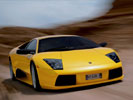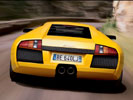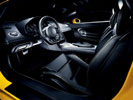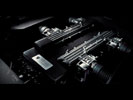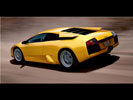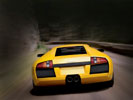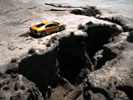The Supercar Resource
2006 Lamborghini Murcielago
Pictures and Specifications
|
Click on above picture to view wallpaper-size picture. |
||
Lamborghini Murcielago
In the late afternoon of October 5th 1879, after a fierce fight in the arena of Cordoba, a bull named Murciélago from Joaquin del Val di Navarra's farm, had his life spared by the famous matador Rafael Molina "Lagartijo". This was a very rare occurrence in bullfighting, and an honour accorded only to those bulls that have shown exceptional courage and spirit in the arena. And Murciélago was indeed such a bull.He was subsequently given to the breeder Don Antonio Miura, and went on to father a formidable line of fighting bulls that extends right down to the present day.
The bull has always been a symbol of power, aggression and courage: characteristics that are shared by all cars of the Lamborghini marque. In depictions of bullfights, bull and matador together form an emblematic unit, an antithetic combination of brute force and elegance. And it is this symbiosis of violence and beauty that makes the spectacle of bullfighting so fascinating. In the context of the arena, the indomitable spirit of the bull becomes a lethal combination of agility and muscular strength, which must be overcome by the grace and skill of the matador.
True to the tradition in which the bull has always been the symbol of the prestigious motorcar company founded by Ferruccio Lamborghini - born under the sign of Taurus, no less - the management at Automobili Lamborghini have decided to baptise the latest car in the noble line with the name of a fighting bull. And so, after a succession of names linked to the world of the corrida, such as Miura, Jslero, Urraco, Bravo, Jalpa and Espada (the latter being Spanish for sword, the weapon of the matador, and thus a symbol for the matador himself) we now have Murciélago - which coincidentally also means "bat" in Spanish. An unusual name, perhaps, but nonetheless one that effectively expresses the dynamism, elegance and power of the latest thoroughbred to emerge from the Lamborghini stable.
The concept
The Lamborghini Murciélago is 2-seater, 2-door coupé (with the now familiar gull-wing doors) based on the traditional Lamborghini layout: mid-mounted V12 engine, typical Lamborghini transmission with the gearbox mounted in front of the engine and the rear differential integrated into the engine unit, permanent four-wheel drive with central viscous coupler. This layout, successfully employed by Lamborghini for more than 30 years, affords an optimal weight distribution (42% front and 58% rear) with conspicuous advantages for traction, braking and handling. The Murciélago chassis has been stiffened considerably to achieve a torsional rigidity value in excess of 20,000 Nm/°. The suspension design (independent double wishbones) represents the best possible solution for a high-performance GT and, again, is in keeping with Lamborghini tradition.
The external bodywork panels are made from carbon fibre, with the exception of the steel roof and door panels. The rear of the car features two "active" intakes for the engine cooling air. With the exclusive VACS ("Variable Air-flow Cooling System"), the aperture of these air intakes can be varied to suit the driving conditions. Furthermore, to ensure correct aerodynamic equilibrium at all speeds, the angle of the rear spoiler can also be altered. According to the speed of the car, the rear spoiler can assume three different positions: closed from 0 to130 km/h, partially open (50°) between 130 and 220 km/h and fully open (70°) above 220 km/h. Depending on the aperture of the air intakes and the position of the rear spoiler, the car's Cx coefficient varies from a minimum of 0.33 to a maximum of 0.36. Bi-xenon headlights produce both main and dipped beams. The wing mirrors can be folded electrically and are mounted on long support arms so that the driver can see beyond the rear wings, which are especially prominent when the air intakes are open. However, mirror stability is not compromised, even at high speeds.
The design
The "mission" was to design a worthy successor to the Lamborghini Diablo: the new car had to be exciting, unmistakable, but also safe and ergonomic. Lamborghini's brief to the designer was simple: "We'll make the engine, you design the body to fit". The result is a creation in steel and carbon fibre precisely tailored to suit the engine, that enhances the performance of its twelve cylinders. The central concepts of the design are purity of line, muscularity, aeronautical influence, efficiency and "made to measure". Certainly the lines of the Murciélago do justice to its illustrious heritage and echo the styling features of some of the most significant icons to be produced by the marque. In its lines can be seen the wedge shape of the Countach, the sensual tension of the Miura and the dramatic proportions of the Diablo, with its futuristic cabin.
The engine
The Murciélago's engine - which complies with the strictest emission standards in the world, including those of the United States, Japan and Europe - is a 12-cylinder 60° V with a displacement of 6192 cc, made entirely from aluminium alloy and designed for unleaded fuel, producing 580 CV (426 kW) at 7500 rpm and 650 Nm torque at 5400 rpm. Torque delivery is optimised across the entire engine operating band (even at engine speeds relatively low for a sports car) thanks to the adoption of a variable-geometry intake system (VIS), variable valve timing (VVT) on both inlet and exhaust camshafts, and the "drive-by-wire" electronic throttle control, which makes for reduced emissions, improved idle speed control and improved driveability. Particularly noteworthy is the fact that at just 2000 rpm, the Murciélago produces more torque than maximum value attained by the majority of Granturismo cars in today's market.
Chassis and Suspension
The Murciélago chassis has been stiffened considerably to achieve a torsional rigidity value in excess of 20,000 Nm/°. The attainment of this value was one of the fundamental objectives of the design programme, and translates into a significant improvement in the car's performance: improved suspension behaviour and handling, greater driving comfort and an appreciable reduction in interior noise. The chassis consists of a frame made of high-strength steel tube, with structural elements in carbon fibre/honeycomb. The carbon fibre elements are attached to the steel frame using a combination of adhesives and steel rivets. The chassis, which has a structural steel roof and a carbon fibre floor pan attached to the tubular frame, incorporates pressed steel panels with stiffening ribs, which also have a structural function.
The dimensions of the aluminium alloy wheel rims with concealed valves are 8 ½ x 18" (front) and 13 x 18"(rear); the sizes of the PIRELLI P Zero "ROSSO" tyres are respectively 245/35 ZR 18 and 335/30 ZR 18. The wheel rims feature a new design that improves the air cooling circulation around the brake disks and calipers. The new tyres allow for a more comfortable ride, reduce road noise and improve handling.
Brakes and Safety
Safety is one of the strong points of the Lamborghini Murciélago. The braking system consists of four disk brakes, each with 4 wheel cylinders per caliper, and two independent hydraulic circuits - one for the front axle and one for the rear. The system includes a tandem master cylinder, a vacuum servo brake, an emergency brake and a parking brake. There is also a 4-channel ABS system with DRP (Dynamic Rear Proportioning) and TCS.
The TRW antilock braking system, which forms an integral part of the basic braking system, consists of an electro-hydraulic control unit and 4 wheel speed sensors. The electro-hydraulic control unit, with dedicated microprocessor, receives the signals from the 4 electromagnetic speed sensors mounted on the hub flanges, and calculates the speed and acceleration of each individual wheel. Using this information, the microprocessor is able to detect a tendency to slip on any wheel and modulate the fluid pressure in the corresponding brake line accordingly, in order to restore the correct speed and thereby maximum braking force on that particular wheel.
The 4-channel system is able to monitor and control each wheel independently. To maintain the safety guaranteed by the two fully independent braking circuits (one for the front and one for the rear brakes) the hydraulic components of the control unit are doubled up, so that no part of the braking system is common to both the front and rear brakes. In the event of a malfunction of the ABS (signalled by a red warning light on the dash) the basic braking system will still continue to function normally. The DRP function has reparameterised with respect to the previous model to guarantee an optimum distribution of the braking force between the front and rear wheels in all conditions - even those not calling for intervention of the ABS.
Passive safety standards have also been significantly improved on the Murciélago: the car is equipped with two airbags, a 60-litre bag with single inflator on the driver's side and a 130-litre bag with dual inflator on the passenger side, which emerges from a new seamlessly upholstered panel. The Murciélago complies with all EU, Japan and US safety standards.
Equipment & Comfort
At the wheel of the Lamborghini Murciélago, the driver is in complete control. The clear, accurate instruments and their respective controls are all grouped together on a single electronically-controlled panel, which has undergone numerous aesthetic and ergonomic improvements. This panel is directly interfaced through a CAN bus to a Lamborghini GFA control unit (body computer).
The instrument panel includes a trip computer that displays average and maximum speed, maximum acceleration, miles to empty (range), a chronometer and a voltmeter. Among the other driver's aids are an electric control to fold the electrically-heated wing mirrors, the non-reflective rearview mirror, and the axle lifting system that, at low speeds, allows the car's front axle to be raised by 45 mm.
The interior features leather upholstery, 3-spoke sports steering wheel (also in leather) and a steel gear lever and selector gate: another refinement that is a long-established Lamborghini tradition. Numerous storage compartments are provided, and the radio and CD autochanger are tailor-made to Lamborghini's specifications. Options include low ratio gears and satellite navigation system. The high-performance characteristics of the Murciélago certainly do not detract from the comfort level, which is significantly improved compared with the Diablo.
The first of these improvements concerns accessibility: the door opening angle has been widened by 5° and the chassis side member directly under the door has been lowered by 25 mm. Interior comfort has also been improved, with more room now available for both the driver and the passenger, achieved by redesigning the side members of the roof and increasing the size of the footwell.
Interior noise levels are much reduced, thanks to the use of optimised soundproofing materials, the elimination of undesirable noise channels, the adoption of integral panels and by fitting acoustic insulation panels to the wheel arches to reduce road noise.
The stiffer chassis also makes an important if indirect contribution to driver comfort. Further improvements in comfort have been obtained by the use of improved thermal insulation on the transmission tunnel and the engine bulkhead.Internal climate control has been greatly improved by the new layout of air outlet vents, an improved system efficiency and a new control algorithm. The Murciélago's climate control system provides the cabin temperature setting ranging between 16 and 31 degrees centigrade, automatic control of the air distribution in the cabin according to the season and the temperature of the outlet air, automatic blower speed control with eight different settings, automatic recirculation and compressor control. The operating limits of the Lamborghini Murciélago's climate control system, which also includes an automatic defroster and full diagnostic functions, are between -29 and +55 degrees centigrade external temperature.
The performance
Thanks to the 580 CV (426 kW) maximum power output of its its 60° V-12 engine, delivered at 7500 rpm, and its 650 Nm maximum torque, the Lamborghini Murciélago can exceed 330 km/h and accelerate from 0 to 100 km/h in 3.8 seconds. Compared with previous models, the driveability of the Murciélago is significantly improved, thanks to the smoother torque curve, increased power, the new 6-speed gearbox and the improved electronic engine management system.
Handling and high-speed stability are also better, thanks mainly to the improved torsional rigidity of the chassis, the lowering of the car's centre of gravity, the optimisation of the suspension and tyres and - last but not least - the improved aerodynamics. The advances made in terms of driveability and performance, apparent even under the most demanding driving conditions, are matched by an equally significant improvement in driving comfort.
. . . ( collapse )Source: Lamborghini S.p.A.
| Performance | |||
| Top Speed | 205+ mph / 330+ kph | 0-60 mph | 3.6 seconds |
| Skidpad | 0.98g | 0-100 mph | 9.5 seconds |
| EPA City / Highway | 9 / 13 | 0 - ¼ Mile | 12.0 sec @ 121 mph |
| Drag Coefficient | 0.33 | 0-100-0 mph | 14.2 seconds |
| Slalom | Not Available | Stopping Distance | 155 ft. from 70 mph |
| General Information | |||
| Base Price | $281,100 | Production | Not Available |
| Powertrain Layout | Mid Engine / AWD | Steering | Rack & Pinion w/ Power Assist |
| Body Material | Carbon Fiber | Front Wheels | 18 x 8.5 in. |
| Brake Type | Vented Discs w/ Power Assist | Rear Wheels | 18 x 13 in. |
| Brake Size | F: 14.0 in. / 355 mm R: 13.2 in. / 335 mm |
Front / Rear Tires | 245/35ZR-18 / 335/30ZR-19 |
| Engine | |||
| Configuration | 6.2-liter V-12 | Displacement | 6,192 cc / 378 cu in. |
| Valvetrain | DOHC 4 valves / cylinder | Bore | 3.43 in. / 87.0 mm |
| Power | 580 bhp @ 7500 rpm | Stroke | 3.42 in. / 86.8 mm |
| Torque | 479 lb-ft @ 5400 rpm | Compression Ratio | 10.7:1 |
| Redline | 7600 rpm | Final Drive Ratio | 2.53:1 |
| Transmission | 6-speed Manual | Gear Ratios | 2.94:1, 2.06:1, 1.52:1, 1.18:1, 1.03:1, 0.91:1 |
| Dimensions | |||
| Wheelbase | 104.9 in. / 2665 mm | Length | 180.3 in. / 4580 mm |
| Front Track | 64.4 in. / 1635 mm | Width | 80.5 in. / 2045 mm |
| Rear Track | 66.7 in. / 1695 mm | Height | 44.7 in. / 1135 mm |
| Weight Distribution | 42/58 | Curb Weight | 3,638 lb. / 1650 kg |

